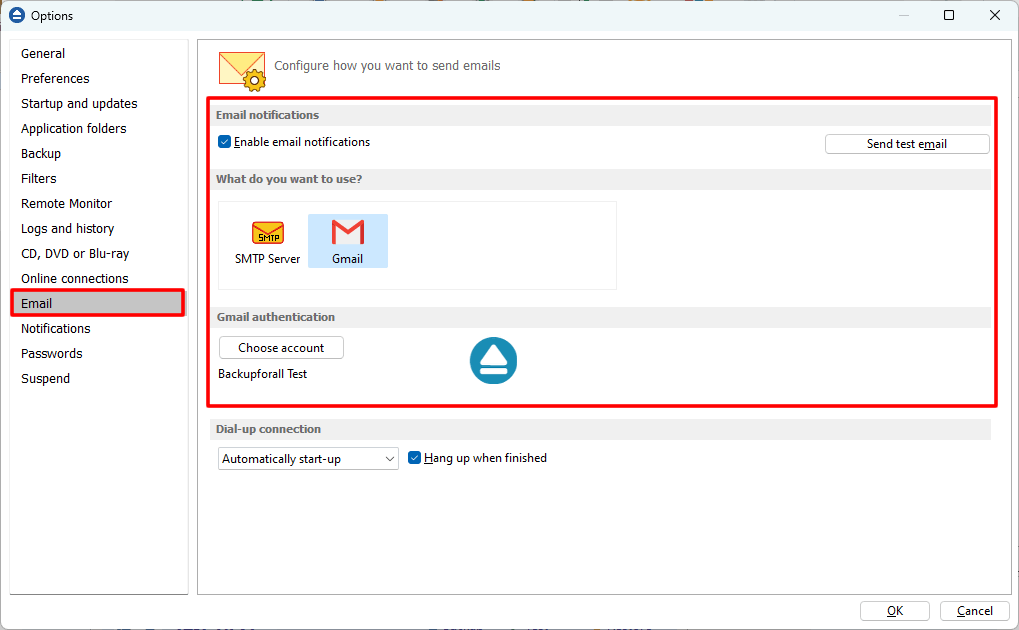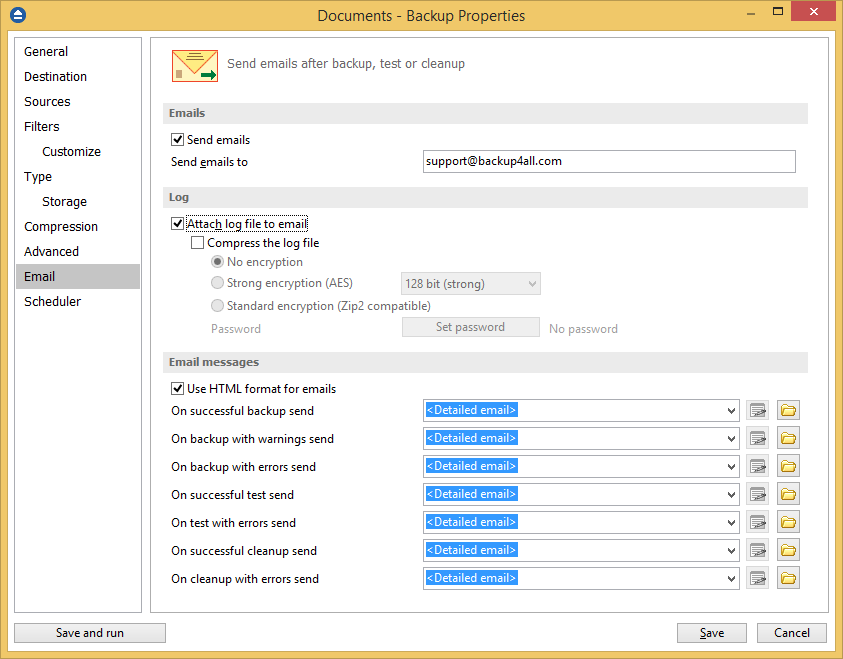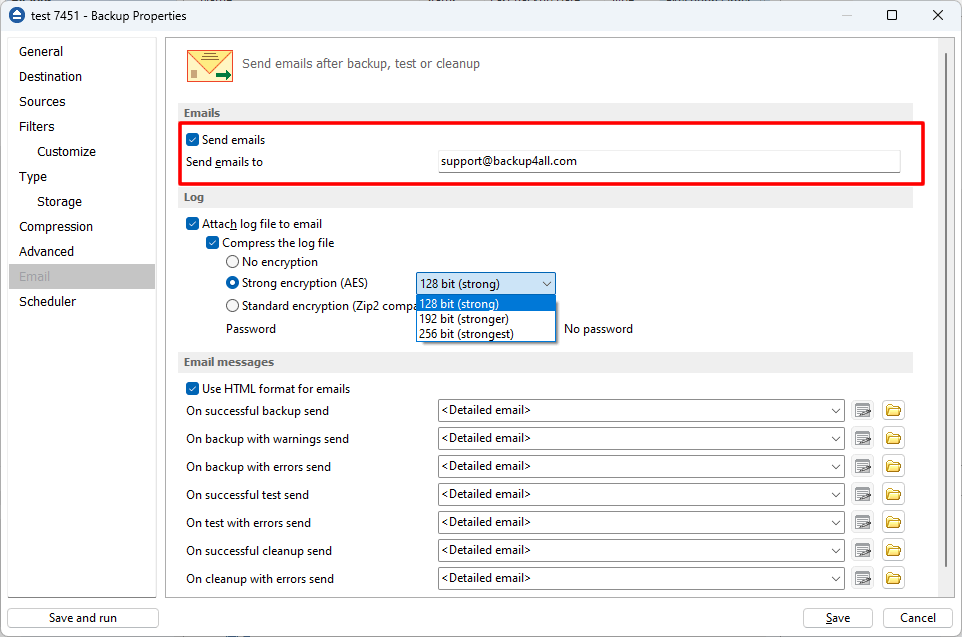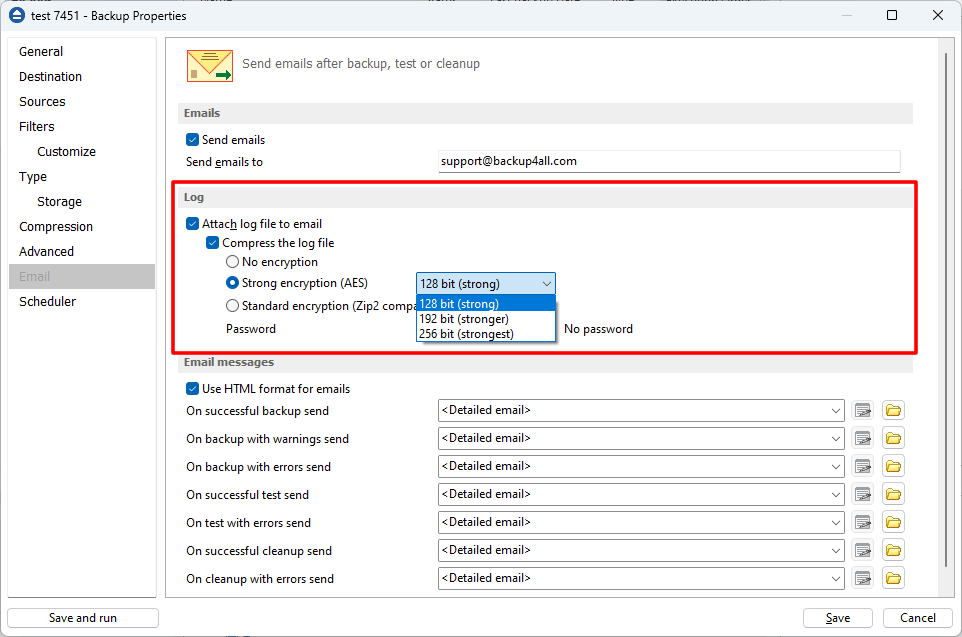This article shows you how to use this section to set email notifications to be sent when the backup is finished. There are three types of email notifications depending on the backup status: success, warning and error email notifications.
On this page:
- How to enable email sending
- Attaching the log file
- Customize email messages
To configure the email server you need to open File -> Options -> Email and check the Enable email notifications option.You'll have to enter the email sending server settings and test those in order to be sure that emails can be sent. Once that option is set, you can configure email sending individually for any backup job.![Backup Properties - Email Backup Properties - Email]() You can enable the email sending for a specific job, right-click that backup job, go to Properties and Email. This will open an email settings window with several options.
You can enable the email sending for a specific job, right-click that backup job, go to Properties and Email. This will open an email settings window with several options.![Backup Properties - Email Backup Properties - Email]()
How to enable email sending
On the email settings page, check the Send emails option and then enter the email addresses you want the notifications sent to in the Send emails to field. You can enter multiple email addresses separated by comma.The notification emails will be sent at the end of the backup, test or cleanup operation to the specified emails.![Backup Properties - Email Backup Properties - Email]()
Attaching the log file
If the Attach log file to email option is checked, the backup log file will be attached to the email.![Backup Properties - Email Backup Properties - Email]() You can also Compress the log file to reduce its size and avoid email bouncebacks. You can choose to encrypt the log file too or leave it unprotected:
You can also Compress the log file to reduce its size and avoid email bouncebacks. You can choose to encrypt the log file too or leave it unprotected: - No encryption. The zipped log file created will not protected by password for unauthorized access.
- Zip(2) compatible encryption. This is the standard Zip 2.0 encryption: an older encryption technique that provides relatively weak security compared to AES encryption. Zip 2.0 encryption format cannot provide protection from individuals with access to specialized password recovery tools. Its advantage over AES encryption is the compatibility with all third party zip applications.
- AES encryption(*). This is the Advanced Encryption Standard, the best choice in zip protection. Backup4all supports AES encryption in three different strengths:
- 128 bit (strong) - size of the encryption key is 128 bits. This provides significantly better security than standard zip 2.0 encryption.
- 192 bit (stronger) - size of the encryption key is 192 bits.
- 256 bit (strongest) - size of the encryption key is 256 bits. This is the strongest encryption method for zipped log file and it provides the best security.
If encryption is enabled you'll have to Set the password that will be required when unzipping.
Note: Backup4all does not store passwords. Make sure that you remember the password used, or you will not be able to extract the log file.
Customize email messages
The Email messages section allows you to configure individual emails that will be sent after the backup job finishes, depending on its status. By default Backup4all will send a Detailed email with information on the backup job, but you can also create your own email template and use it instead.
The default email is
<Detailed email>, but you can pick one that you created by clicking the Browse button. The Edit is enabled only if you are using a custom email template created by you (doesn't work with the default email).If you don't want an email to be sent for a job status, just select
<No email> from the drop-down of that notification field.Options for sending the emails:
- On successful backup send. This is the email that will be sent when the backup is finished with success.
- On backup with warnings send. Email that will be sent when the backup is finished with warnings.
- On backup with errors send. Email that will be sent when the backup has failed because of an error.
- On successful test send. Indicates the email that will be sent when the test operation is finished with success.
- On test with errors send. The email that will be sent when the test operation failed because of an error.
- On successful cleanup send. Email that will be sent when the cleanup operation is finished with success.
- On cleanup with error send. Email that will be sent when the cleanup operation failed because of an error.
Customizing emails
If you want to create a customized email to be sent (on success/warning/error), the email template will have to include special tags that Backup4all will recognize and replace according to the description below (note that the format of the tag must be
<#tag_name>):<#BACKUP_NAME>- will insert the name of the executed backup job<#TAG_NAME>- will insert the name of the backup tag<#SOURCES>- will insert the sources of the executed backup<#DEST_DRIVE>- will insert the destination drive letter<#DEST_DRIVE_TYPE>- will insert the destination drive type<#DEST_FOLDER>- will insert the name of the destination folder<#DEST_CATALOG_FILE>- will insert the name of the catalog file created<#BACKUP_TYPE>- will insert the backup type that was performed<#SCHED_NEXT_EXECUTION>- will insert the next scheduled execution<#SCHED_NEXT_TAG_EXECUTION>- will insert the next scheduled tag execution<#BACKUP_START_TIME>- will insert the start time of the backup executed<#BACKUP_END_TIME>- will insert the end time of the backup executed<#TEST_START_TIME>- will insert the start time of test<#TEST_END_TIME>- will insert end time of test<#LAST_BACKUP_SIZE_COMPR>- will insert the resulted size of the last backup<#TOTAL_BACKUP_SIZE>- will insert the total backup size<#REMAINING_DISC_SPACE>- will insert the remaining space on the destination drive<#NBR_FILES_ADDED>- will insert the number of files added to the backup<#SIZE_FILE_ADDED>- will insert the size of the added files<#NBR_FILE_WARNINGS>- will insert the number of warnings<#NBR_ERRORS>- will insert the number of errors<#LAST_LOG_NAME>- will insert the name of the last log file<#EXCLUDED_SOURCES>- will insert the list of sources excluded<#TESTED_VERSIONS>- will insert the list of tested backup numbers<#TEST_SUMMARY>- will insert the detailed list of test backup numbers<#REMOVED_VERSIONS>- will insert the list of backups removed after cleanup<#CLEANUP_SUMMARY>- will insert the detailed list of backup numbers removed<#CLEANUP_START_TIME>- will insert the start time of cleanup<#CLEANUP_END_TIME>- will insert the end time of cleanup<#PROCESSED_SIZE>- will insert the total size of the files removed
For an example of tag usage, open one of the 5 default emails. The emails are stored in text format in application's directory (i.e.
C:\Program Files (x86)\Softland\Backup4all 8\) with the following filenames: SuccessFullEmail.txt, WarningFullEmail.txt, ErrorFullEmail.txt for backup emails, TestSuccessFullEmail.txt and TestErrorFullEmail.txt for test emails.The subject line of the email sent can be customized too by adding the following line at the beginning of the customized file that will be used by Backup4all as an email:
<! Subject of the email !>Here is an example of a customized email that can be sent when a cleanup operation is successful (note that the first line of this will be used as the subject line of the email):
<!Cleanup for <#BACKUP_NAME> finished successfully at <#CLEANUP_END_TIME>!>
Cleanup for backup job <#BACKUP_NAME> at <#CLEANUP_START_TIME> finished successfully.
See log file <#LAST_LOG_NAME> for more information.
Removed backups : <#REMOVED_VERSIONS>
Removed version details:
<#CLEANUP_SUMMARY>
-----
Total removed file size : <#PROCESSED_SIZE>
Free space on destination: <#REMAINING_DISC_SPACE>
Cleanup started at: <#CLEANUP_START_TIME>
Cleanup finished at: <#CLEANUP_END_TIME>






